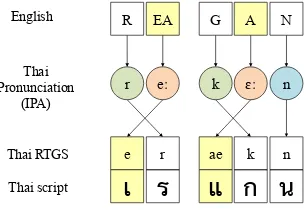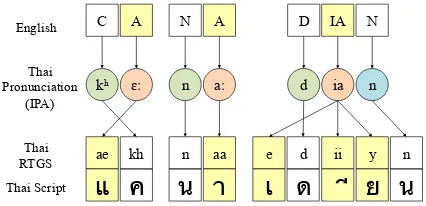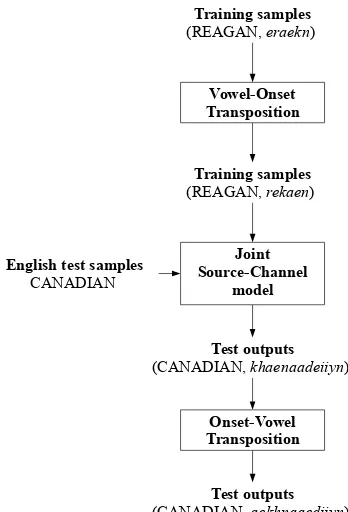Regulating Orthography-Phonology Relationship
for English to Thai Transliteration
Binh Minh Nguyen National University of
Singapore, Singapore
nguyen.binh.minh92@u.nus.edu
Gia H. Ngo National University of
Singapore, Singapore
ngohgia@u.nus.edu
Nancy F. Chen Institute for Infocomm
Research, Singapore
nfychen@i2r.a-star.edu.sg
Abstract
In this paper, we discuss our endeavors for the Named Entities Workshop (NEWS) 2016 transliteration shared task, where we focus on English to Thai transliteration. The alignment between Thai orthography and phonology is not always monotonous, but few transliteration systems take this into account. In our proposed system, we exploit phonological knowledge to resolve problematic instances where the monotonous alignment assumption breaks down. We achieve a 29% relative im-provement over the baseline system for the NEWS 2016 transliteration shared task. 1 Introduction
Transliteration is the process of transform-ing a word from one writtransform-ing system (source word) to a word in another writing system (target word) (Knight and Graehl, 1998). Transliteration is often used to borrow names and technical terms from the source language into the target language when translation is difficult or awkward. For ex-ample,Britishis transliterated into Thai as [bri-tit
] using Royal Thai General System of Transcrip-tion (RTGS) notaTranscrip-tion (Royal Institute, 1999).
Transliteration can be formulated as a special case of translation. Instead of converting words from one language to the semantically equivalent words in another language, transliteration converts the source word to a phonetically equivalent target word (Knight and Graehl, 1998).
In transliteration, character-reordering is im-portant to ensure the transliterated words fol-low the phonotactic rules of the target language. Character-reordering in transliteration is similar to word-reordering in translation, where the trans-lated sentence needs to satisfy the grammatical rules of the target language. However, most
transliteration systems do not take into account character-reordering.
If the phonetically equivalent characters are reordered in the target word, the source word and the transliterated word are said to be non-monotonously aligned (Toms and Casacuberta, 2006). A classical approach to transliteration is using phrase-based Statistical Machine Transla-tion (pbSMT). While pbSMT approach can model non-monotonous alignment of characters in the transliteration task, the pbSMT systems intro-duced in Kunchukuttan and Bhattacharyya (2015), Nicolai et al. (2015) and Finch et al. (2015) did not model such character-reordering. In addition to pbSMT, Nicolai et al. (2015) also used grapheme-to-phoneme (G2P) conversion tools, namely Di-recTL+ (Jiampojamarn et al., 2010) and Sequitur G2P (Bisani and Ney, 2008), for the translitera-tion task. Such G2P conversion tools also make a similar assumption of monotonous alignment be-tween source and target word. While this assump-tion is reasonable for transliteraassump-tion between most language pairs, there are cases in English to Thai transliteration whereby this assumption is invalid. In this paper, we regulate the relationship be-tween Thai orthography and phonology in the En-glish to Thai transliteration task. We show that the transliteration accuracy can be improved by ad-dressing the mismatch between Thai orthography and phonology that causes the monotonous align-ment assumption to break down.
2 Thai Phonology
2.1 Syllable
A syllable is considered the basic unit of a word in both written and spoken language (Ladefoged and Johnson, 2014). Most languages have the following syllable structure, including English and Thai (Kessler and Treiman, 1997; Luksa-neeyanawin, 1992):
[O] N [Cd] [T] (1)
whereO,N,Cd,T denotes onset, nucleus, coda, tone respectively.
In Thai, an onset (O) has at most two conso-nants and a coda (Cd) has at most one consonant, while a nucleus (N) can be a vowel or a diph-thong (Luksaneeyanawin, 1992). Tone (T) is a feature of many tonal languages (Yip, 2002). Tone is a variation in pitch that is used to distinguish different words (Yip, 2002). For example, both the Thai words valueandto trade have the same syllable [khaa] (RTGS), butvalueis pronounced with a falling tone while to trade is pronounced with a high tone.
The aim of transliteration is to generate a word in the target language that best matches the pronunciation of the word in the source lan-guage (Knight and Graehl, 1998). Although the syllable structure in English and in Thai are sim-ilar, the idiosyncratic relationship between Thai pronunciation and Thai orthography makes En-glish to Thai transliteration complex.
1. In Thai orthography, the position of the on-set and nucleus can be inverted for a sylla-ble with a leading vowel (Chotimongkol and Black, 2000). A leading vowel is part of the syllable’s nucleus. While the vowels of the nucleus are pronounced after the consonants of the onset as specified by the syllable struc-ture in (1), leading vowels precede the con-sonants of the onset in written form. The or-der of consonants and vowels in Thai writ-ten form therefore does not always match the pronunciation order. This is unlike English whereby the order of consonants and vowels in the written form matches the order in pro-nunciation. For example,Reaganis translit-erated into Thai as [er-aekn] (RTGS) but is pronounced in Thai as [re:kE:n] (IPA). [ e ]
and [ea] are leading vowels and are written before their corresponding onset which are [
r] and [k] respectively.
2. Lexical tones in Thai are not uniquely defined by tone marks, but are determined by the type of the syllable, the class of the onset conso-nant, and the length of the nucleus (Smyth, 2002). For example, the Thai words for both
to pass andglancingare pronounced with a low tone. However, onlyto pass has a tone
mark in Thai script, whileglancingdoes not. 3. Some vowels are implicit in certain phonetic contexts (Chotimongkol and Black, 2000). Such vowels are present when the syllable is pronounced but it is omitted when the syl-lable is transcribed. For example, Steve is transliterated as [s-tip] but is pronounced as [ sa-tip ] (RTGS). In this case, the vowel [a] is implicit.
In this work, we focus on the onset-nucleus inver-sion case (case 1), which occurs much more often.
2.2 Alignment between Thai Orthography and Phonology
Even though the syllable structure of English and Thai are similar, the mismatch between Thai orthography and Thai syllable structure can lead to challenges in aligning English-Thai transliteration word pairs. In this section, we describe how onset-nucleus inversion may make monotonous align-ment difficult.
English
Thai RTGS
Thai script
B R I T I SH
b r i t i t
บ
ร
ต
ช
Thai Pronunciation
(IPA)
b r i t i tɕʰ
Consonant
Syllable 2
Vowel Onset Nucleus Coda
ิ
Syllable 1
ิ
Figure 1: Monotonous Alignment, the source word isBritish
When there is no onset-nucleus inversion such as the case in Figure 1, the alignment between the English word and the Thai word is monotonous.
R EA G A N
e r ae k n
เ
ร
แ
ก
น
eː k ɛː n r
English
Thai RTGS
Thai script Thai Pronunciation
[image:2.595.331.502.346.486.2](IPA)
Figure 2: Non-Monotonous alignment of English-Thai transliteration pairs due to onset-nucleus in-version of monophthongs.
[image:2.595.341.495.577.682.2]non-monotonous. Under the monotonous align-ment assumption, the English onset [ R ] may be wrongly aligned to the Thai nucleus [e], and the English nucleus [ EA ] may be wrongly aligned to the Thai onset [ r ]. The English syllable [ REA ] may still be aligned correctly to the Thai syllable [er] if the syllables appear together fre-quently in the training data. Nevertheless, the presence of onset-nucleus inversion increases the number of possible alignments between English-Thai transliteration pairs.
C A N A D IA
ae kh n aa e
แ
ค
น
า
เ
N
d ii y n
ด
ย
น
English
Thai RTGS Thai Script
Thai Pronunciation
(IPA)
n ia d aː
n
ɛː
kʰ
[image:3.595.75.288.217.320.2]ี
Figure 3: Non-Monotonous alignment of English-Thai transliteration pairs due to onset-nucleus in-version of diphthongs.
Onset-nucleus inversion also occurs in syllables with diphthongs. In Figure 3, the nucleus of the third syllable, namely [e] [ ii ] [ y ], is a diph-thong in Thai, which comprises of three phonemes [ e], [ii] and [ y ]. Although [e], [ii] and [ y ] are components of the same nucleus, they are not adjacent. Under the monotonous alignment as-sumption, it is unclear how to align the English onset, nucleus and coda with Thai onset, nucleus and coda respectively. We attempt to address these issues in the proposed transliteration system. 3 Baseline Systems
We considered two classic approaches as our baseline systems. Transliteration seeks to convert an English stringf = (f1, f2, . . . , fn) to a Thai
stringe= (e1, e2, . . . , em).
3.1 Phrase-based Statistical Machine Translation System
Under the pbSMT system, the objective func-tion is given by:
e∗= arg max
e p(e)p(f |e), (2) wherep(e)is estimated from an n-gram language model of Thai, and p(f | e) is estimated from the alignment of segments (phrases) offwith seg-ments (phrases) ofe.
We implement the pbSMT system with the Moses toolkit (Koehn et al., 2007). We use GIZA++ (Och and Ney, 2003) to perform
align-ment, and SRILM (Stolcke, 2002) to train a 5-gram language model of Thai transliteration units with Witten-Bell smoothing (Witten and Bell, 1991). While the pbSMT systems imple-mented in (Kunchukuttan and Bhattacharyya, 2015) and (Nicolai et al., 2015) did not model word reordering, we tried various reordering mod-els offered by the Moses toolkit.
3.2 Joint Source-channel System
The baseline system is based on the joint source-channel model, formulated for translitera-tion in (Li et al., 2004). A similar model (joint sequence model) was proposed for grapheme-to-phoneme conversion in (Bisani and Ney, 2002). We use the Sequitur G2P tool from (Bisani and Ney, 2008) to train the joint source-channel model by assuming a direct correspondence between phoneme and grapheme in the target language.
Given an English string f and a Thai string e, the joint source-channel model estimates the co-segmentation q, defined as q = (q1, q2, . . . , qn)
where, qi = (fi, ei), f = (f1, f2, . . . , fn) and
e = (e1, e2, . . . , en). During decoding, the
out-put Thai string corresponds to the co-segmentation that matches the input English string and yields the maximum likelihood.
The monotonous alignment assumption is built into the joint source-channel model (Bisani and Ney, 2008). Under this assumption, ∀i < j, fi
appears before fj andei appears before ej. In a
Thai syllable with onset-nucleus inversion,ei
cor-responds to a leading vowel andei+1corresponds
to the onset that comes after the leading vowel. However,fi andfi+1may still be matched to the
onset and nucleus in the English syllable. There-fore, the model may be confused, as the English onset is matched to the Thai nucleus, and the En-glish nucleus is matched to the Thai onset. 4 Proposed Augmented System
The proposed system (Figure 4) augmented the joint source-channel model with a vowel-onset transposition step to regulate the syllable structure. During training, for Thai syllables with onset-nucleus inversion, the vowel-onset transposition step swaps the location of the leading vowel and the onset consonant (see next page). This swap-ping ensures that the nucleus always occurs after the onset in a syllable, and vowels that belong to the same nucleus are adjacent in the Thai script.
Training samples
(REAGAN, eraekn)
Training samples
(REAGAN, rekaen)
Vowel-Onset Transposition
Joint Source-Channel
model English test samples
CANADIAN
Test outputs
(CANADIAN, khaenaadeiiyn)
Onset-Vowel Transposition
Test outputs
[image:4.595.309.526.61.133.2](CANADIAN, aekhnaaediiyn)
Figure 4: Augmented System. English words are capitalized, Thai words are italicized RTGS.
input :Thai word
output:Regulated Thai word
whilenot end of worddo
ifcharacter is leading vowelthen
swap position of vowel and onset; go to character after leading vowel;
else
go to next character;
end end
Vowel-Onset Transposition
via onset-vowel transposition. 5 Experiments
We used the TOP-1 metric (Banchs et al., 2015) for performance comparison between the base-line and the augmented systems. As denoted in Table 1, 75% of the NEWS2016 training set was used for training, the remaining 25% of the NEWS2016 training set was used for tuning, and the NEWS2016 dev set was used for testing. A 6-gram joint source-channel model was used for Baseline joint S-C and Augmented 1. Reordering option ‘msd-bidirectional-fe’ in Moses was used for the Baseline pbSMT system as it yielded the best TOP-1 metric.
From Table 2, on the NEWS2016 test set, the
System Set-up
Baseline pbSMT Train = 75% NEWS 2016 training Baseline joint S-C Tune = 25% NEWS 2016 training Augmented 1
Augmented 2 Train = NEWS 2016 training Tune = NEWS 2016 dev
Table 1: Data partitioning for the different sys-tems. (pbSMT: phrase-based statistical machine translation, joint S-C: joint source-channel)
System Dev Set Test Set
[image:4.595.90.264.64.320.2]Baseline pbSMT 0.3117 0.111650 Baseline joint S-C 0.3662 0.117314 Augmented 1 0.4015 0.144013 Augmented 2 NA 0.155340
Table 2: Results on NEWS 2016 shared task in terms of TOP-1 accuracy.
augmented system (Augmented 1) achieves a 29% relative improvement over the pbSMT baseline system (Baseline pbSMT), and a 23% relative im-provement over the joint source-channel baseline system (Baseline joint S-C).
To observe the performance of the augmented system with the full training data, we trained an-other separated augmented system (Augmented 2), using both the training set and the dev set data as denoted in Table 1. A 6-gram joint source-channel model was also used for this augmented system. Despite a simpler setup due to exploiting phonology knowledge, this system achieves com-parable performance to that of systems reported in (Nicolai et al., 2015) and (Finch et al., 2015) for English to Thai transliteration task.
6 Discussion
[image:4.595.316.514.194.265.2]References
Rafael E. Banchs, Min Zhang, Xiangyu Duan, Haizhou Li, and A. Kumaran. 2015. Report of NEWS 2015 Machine Transliteration Shared Task. In Proceed-ings of NEWS 2015 The Fifth Named Entities Work-shop, page 10.
Maximilian Bisani and Hermann Ney. 2002. Investi-gations on joint-multigram models for grapheme-to-phoneme conversion. InINTERSPEECH.
Maximilian Bisani and Hermann Ney. 2008. Joint-sequence models for grapheme-to-phoneme conver-sion.Speech Communication, 50(5):434–451. Ananlada Chotimongkol and Alan W. Black. 2000.
Statistically trained orthographic to sound models for Thai. InINTERSPEECH, pages 551–554. Andrew Finch, Lemao Liu, Xiaolin Wang, and Eiichiro
Sumita. 2015. Neural Network Transduction Mod-els in Transliteration Generation. In Proceedings of NEWS 2015 The Fifth Named Entities Workshop, page 61.
Sittichai Jiampojamarn, Colin Cherry, and Grzegorz Kondrak. 2010. Integrating joint n-gram features into a discriminative training framework.
Brett Kessler and Rebecca Treiman. 1997. Syllable structure and the distribution of phonemes in en-glish syllables. Journal of Memory and Language, 37(3):295–311.
Kevin Knight and Jonathan Graehl. 1998. Ma-chine transliteration. Computational Linguistics, 24(4):599–612.
Philipp Koehn, Hieu Hoang, Alexandra Birch, Chris Callison-Burch, Marcello Federico, Nicola Bertoldi, Brooke Cowan, Wade Shen, Christine Moran, Richard Zens, et al. 2007. Moses: Open source toolkit for statistical machine translation. In Pro-ceedings of the 45th annual meeting of the ACL on interactive poster and demonstration sessions, pages 177–180. Association for Computational Linguis-tics.
Anoop Kunchukuttan and Pushpak Bhattacharyya. 2015. Data representation methods and use of mined corpora for Indian language transliteration. In Pro-ceedings of NEWS 2015 The Fifth Named Entities Workshop, page 78.
Peter Ladefoged and Keith Johnson. 2014.A course in phonetics. Cengage learning.
Haizhou Li, Min Zhang, and Jian Su. 2004. A joint source-channel model for machine transliteration. In Proceedings of the 42nd Annual Meeting on as-sociation for Computational Linguistics, page 159. Association for Computational Linguistics.
Sudaporn Luksaneeyanawin. 1992. Three-dimensional phonology: a historical implication. In Proceedings of the Third International Symposium
on Language and Linguistics: Pan Asiatic Linguis-tics, volume 1, pages 75–90.
Hoang Gia Ngo, Nancy F. Chen, Binh Minh Nguyen, Bin Ma, and Haizhou Li. 2015. Phonology-Augmented Statistical Transliteration for Low-Resource Languages. InSixteenth Annual Confer-ence of the International Speech Communication As-sociation.
Garrett Nicolai, Bradley Hauer, Mohammad Salameh, Adam St Arnaud, Ying Xu, Lei Yao, and Grzegorz Kondrak. 2015. Multiple System Combination for Transliteration. InProceedings of NEWS 2015 The Fifth Named Entities Workshop, page 72.
Franz Josef Och and Hermann Ney. 2003. A sys-tematic comparison of various statistical alignment models. Computational linguistics, 29(1):19–51. Royal Institute. 1999. Principles of romanization for
thai script by transcription method.
D. Smyth. 2002. Thai: An Essential Grammar. Es-sential grammar. Routledge.
Andreas Stolcke. 2002. Srilm-an extensible language modeling toolkit. InINTERSPEECH, volume 2002, page 2002.
Jess Toms and Francisco Casacuberta. 2006. Statis-tical phrase-based models for interactive computer-assisted translation. In Proceedings of the COL-ING/ACL on Main conference poster sessions, pages 835–841. Association for Computational Linguis-tics.
Ian H Witten and Timothy C Bell. 1991. The zero-frequency problem: Estimating the probabilities of novel events in adaptive text compression. Infor-mation Theory, IEEE Transactions on, 37(4):1085– 1094.


